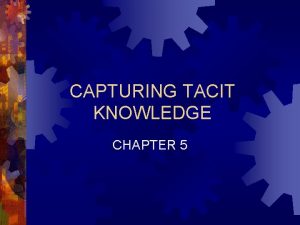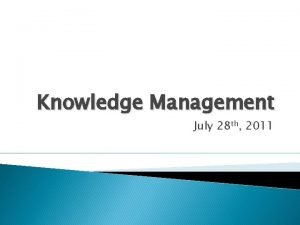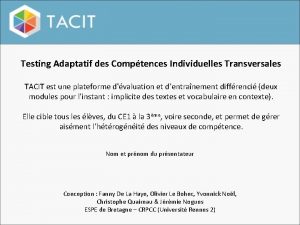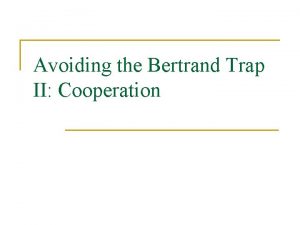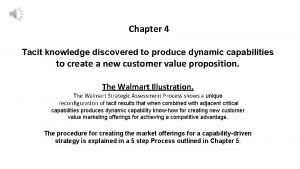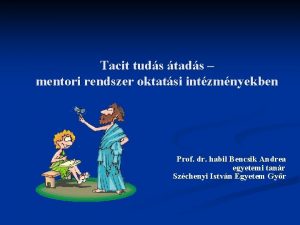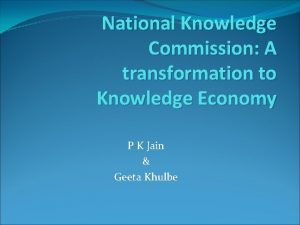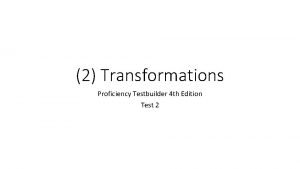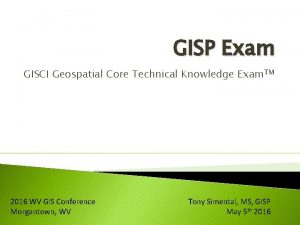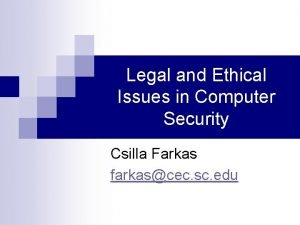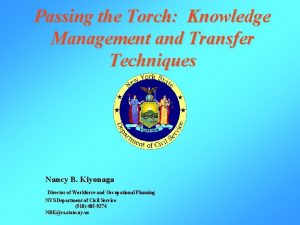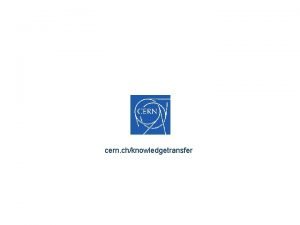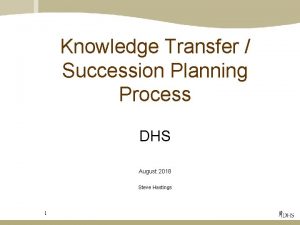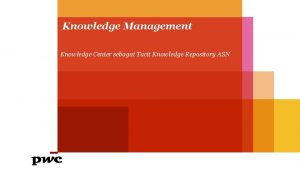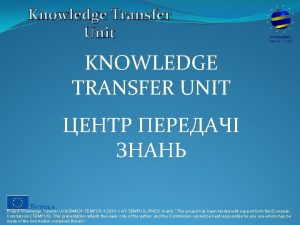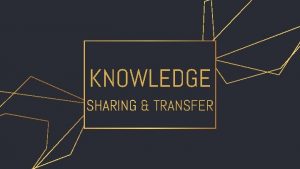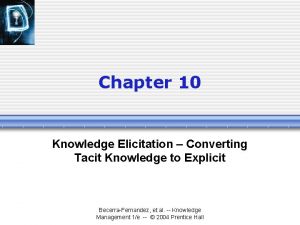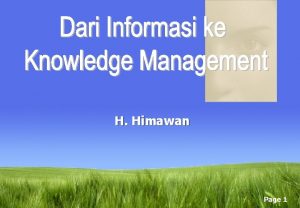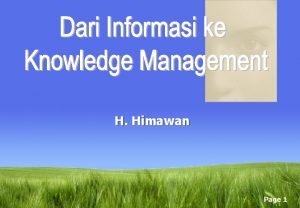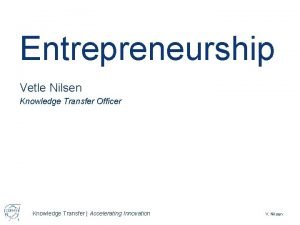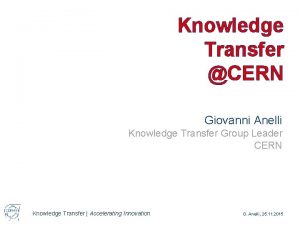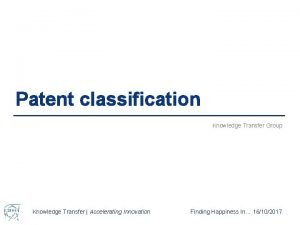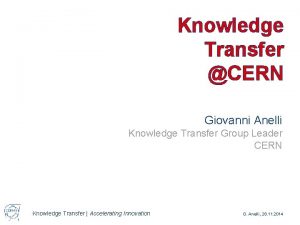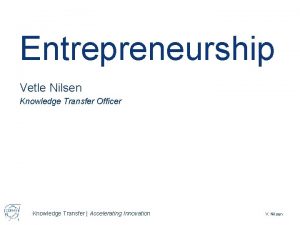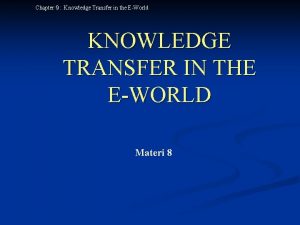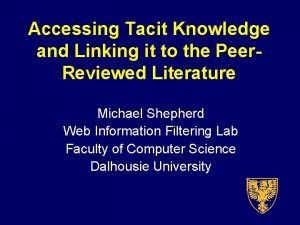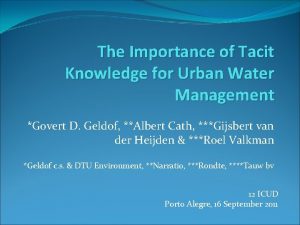The Impact of Tacit Knowledge Transfer during Technical



















- Slides: 19

The Impact of Tacit Knowledge Transfer during Technical Training in Online Learning Environments Amanda Kuhnley

Objectives Define tacit knowledge Introduce research problem Review literature & significance State the research question & hypothesis Describe instrument, sample & data collection Address limitations & contingency plan Clarify contribution to the field List references

Tacit Knowledge Howells (1996) describes Michael Polanyi (1966) tacit knowledge as nonargued that tacit codified, disembodied knowledge is more knowledge that is acquired fundamental than explicit through the informal take. Yi (2006) lists criteria toknowledge. He is up of learned behavior and differentiate tacit famously quoted, “we can procedures. knowledge from explicit know more than we can knowledge. These criteria tell” (p. 4). Zack (1999) describes tacit include (a) personal, (b) Durrance (1998) claims knowledge as subconsciously difficult to communicate, (c) tacit knowledge to live understood and applied while in an individual’s problematic, and (d) being difficult to articulate, “hunches, intuition, contextual. developed from direct emotions, values, and experience, and shared beliefs” (p. 24). through interactive conversation, storytelling, and shared experience.

Why Tacit Knowledge? Undergraduate research Problem-based learning Designed curriculum “Education is the kindling of a flame, not the filling of a vessel” – Socrates Undergraduate degrees Technology Design

Research Problem Alic (2008) Durrance (1998) Zack (1999) Howells (1996) global economic competition, traditional education is not enough tacit knowledge is overlooked in the U. S. tacit knowledge = competitive performance among organizations technology allows for “tacit knowledge networks”

Literature Review Tacit knowledge cannot be captured or transferred Tacit knowledge can be captured and transferred among individuals via online learning environments Polanyi (1966) Tsoukas (2003) Moallem (2003) Ozdemir (2008) Nonaka (1994) Durrance (1998) Eraut (2000) Zollo & Winter (2002) Yi (2006) Harris (2008) Tee & Kearney (2010)

Assumptions Tacit knowledge can be shared through online learning environments Shared experience is the most effective way to transfer tacit knowledge in online learning environments Transfer of tacit knowledge requires the active participation of the employee during technical training

Question and Hypothesis Can the believability of a training simulation influence the transfer of tacit knowledge in an online learning environment for technical training? Employees will be more open to completing technical training and engaging in the transfer of tacit knowledge if they can believe in the training simulation.

Variables Independent • Believability • Shared experience Dependent • Tacit knowledge transfer Control • Perceived experience • Perceived expectations Confounding • Years of experience • Participation in training

Decision for Survey Research Qualitative Yi (2006) – College Qualitative Harris (2008) – SME’s Qualitative Tea & Kearney (2010) – Corporation Mixed Methods Foos, Schum, & Rothenburg (2006)

Survey Questions Independent • Believability (Likert: Believable – Unbelievable) • Shared experience (Likert: Strongly Agree – Strongly Disagree) Dependent • Tacit knowledge transfer (Likert: Strongly Agree – Strongly Disagree) Control • Perceived experience (Likert: Strongly Agree – Strongly Disagree) • Perceived expectations (Likert: Strongly Agree – Strongly Disagree) Confounding • Years of experience (Slider – number) • Participation in training (Likert: Never – Daily)

Survey Instrument

Example Results Table 1: Control variable – overall experience How would you rate your experience with computer-based technical training? (Strongly Agree 1 - Strongly Disagree 4) I think training was applicable to my current job n = 50 μ=1 σ=0 I think training introduced to me new knowledge n = 50 μ=1 σ=0 I think training improved my performance n = 50 μ=1 σ=0

Population and Sample Field Service Technicians Fortune 500 Company – Pepsi. Co Convenience Sample – Virginia Market Unit All 100 field service technicians All complete computer-based technical training Goal: 50 responses HR Representative Kristen Mc. Cullough

Contingency Plan Sample size Other market units Interview protocol Unlikely to not meet sample size!

Fin a The lize sis Def e The nd sis Ana Res lyze ults Wr ite 4 a Ch. nd 5 IR atio B n Rel e Sur ase vey tific Cer r tion dua Gra Fal Seml est e Sum Sem mer est er Spr Sem ing est er Data Collection and Timeline

Limitations Common threats to survey research: location, instrument decay, and mortality Location – one market unit Instrumentation – closed questions, Likert scale Instrument decay – short time period, no changes Mortality – individual experiences Generalizability – limited in size and scope

Contribution to the Field Quantitative study of tacit knowledge – novel idea Step toward validating the measure of tacit knowledge General framework and survey Could be solicited to larger/more diverse samples

References Alic, J. A. (2008). Technical knowledge and experiential learning: what people know and can do. Technology Analysis & Strategic Management, 20(4), 427 -442. doi: 10. 1080/09537320802141403 Durrance, B. (1998). Some explicit thoughts on tacit learning. Training & Development, 52(12), 24 -29. Retrieved from EBSCOhost. Eraut, M. (2000, March). Non-formal learning and tacit knowledge in professional work. British Journal of Educational Psychology. pp. 113 -136. Retrieved from EBSCOhost. Foos, T. , Schum, G. , & Rothernburg, S. (2006). Tacit knowledge transfer and the knowledge disconnect. Journal of Knowledge Management, 10 (1), 6 -18. Doi: 10. 1108/13673270610650067 Harris, R. J. (2009). Improving tacit knowledge transfer within SMEs through e-collaboration. Journal of European Industrial Training, 33(3), 215 -231. Doi: 10. 1108/03090590910950587 Howells, J. (1996). Tacit knowledge, innovation and technology transfer. Technology Analysis & Strategic Management, 8(2), 91 -106. Doi: 10. 1080/00420980220128354 Likert, R. (1932). A technique for measurement of attitudes. Archives of Psychology, 22 (140), 1 -55. Moallem, M. (2003). An interactive online course: a collaborative design model. Educational Technology Research and Development, 51(4), 85 -103. Retrieved from EBSCOhost. Nelson, R. & Winter, S. G. (1982). An evolutionary theory of economic change. Harvard University Press, Cambridge, MA. Nonaka, I. (1994). A Dynamic Theory of Organizational Knowledge Creation. Organization Science, 5(1), 14 -37. Retrieved from EBSCOhost. Ozdemir, S. (2008). E-learning’s effect on knowledge: Can you download tacit knowledge? British Journal of Educational Technology, 39(3), 552 -554. Doi: 10. 1111/j. 14678535. 2007. 00764 x Polanyi, M. (1983). The tacit dimension / Michael Polanyi. Gloucester, Mass. ; Peter Smith, 1983. Retrieved from JAMES MADISON UNIV's Catalog database. Sclove, S. L. (2011). Notes on Likert scales. University of Illinois at Chicago. Retrieved from, http: //www. uic. edu/classes/idsc/ids 270 sls/likert. htm Tee, M. Y. , & Karney, D. (2010). Sharing and cultivating tacit knowledge in an online learning environment. Computer-Supported Collaborative Learning, 5(4), 385 -413. Retrieved from EBSCOhost. Teece, D. J. , Pisano, G. & Shuen, A. (1997) Dynamic capabilities and strategic management. Strategic Management Journal, 18 (7), 509 -533. Retrieved from EBSCOhost. Tsoukas, H. (2003). Do we really understand tacit knowledge? [Electronic source: http: //is. lse. ac. uk/Events/ESRCseminars/tsoukas. pdf]. In M. Easterby-Smith & M. A. Lyles (Eds. ), The Blackwell handbook of organizational learning and knowledge management. Malden: Blackwell Pub. Werner, J. M. , & De. Simone, R. L. (2009). Human resource development. Mason, OH: South-Western Cengage Learning. Yi, J. (2006). Externalization of tacit knowledge in online environments. International Journal on E-Learning, 5(4), 663 -674. Retrieved from EBSCOhost. Zack, M. H. (1999). Managing Codified Knowledge. (cover story). Sloan Management Review, 40(4), 45 -58. Retrieved from EBSCOhost. Zollo, M. & Winter, S. G. (2002). Deliberative learning and the evolution of dynamic capabilities. Organization Science, 13 (3), 339 -351. Retrieved from http: //www/jstor. org/stable. 3086025
 Tacit knowledge
Tacit knowledge Tacit knowledge is the cumulative store of
Tacit knowledge is the cumulative store of Scuppernongs in to kill a mockingbird
Scuppernongs in to kill a mockingbird Tacit élève
Tacit élève Tacit collusion
Tacit collusion Tacit collusion
Tacit collusion Tacit ch 4
Tacit ch 4 Tacit tudás
Tacit tudás Conclusion of national knowledge commission
Conclusion of national knowledge commission John has hinted that he doesn't wish to remain in the group
John has hinted that he doesn't wish to remain in the group Gisci geospatial core technical knowledge exam
Gisci geospatial core technical knowledge exam Attack sophistication vs intruder technical knowledge
Attack sophistication vs intruder technical knowledge Energy transfer during exercise
Energy transfer during exercise Disturbance that transfers energy
Disturbance that transfers energy Cern knowledge transfer
Cern knowledge transfer Knowledge transfer in e world
Knowledge transfer in e world Knowledge transfer techniques
Knowledge transfer techniques Collaboration agreement for technology transfer
Collaboration agreement for technology transfer Cern kt
Cern kt Knowledge silo matrix
Knowledge silo matrix
